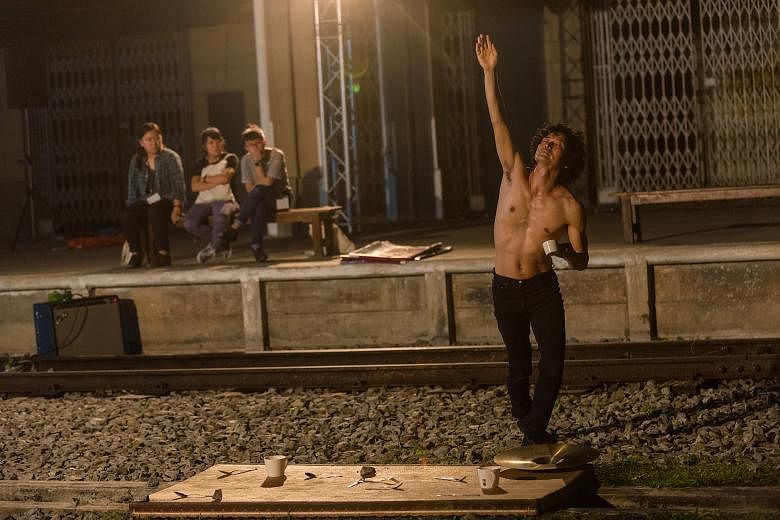REVIEW / DANCE
DOUBLE BILL: REAL REALITY, LAY/ERED
Mikuni Yanaihara, Yukio Suzuki SIFA Dance Marathon: Open With A Punk Spirit Tanjong Pagar Railway Station/Tuesday
After the two equally assertive, yet diametrically different pieces on the Dance Marathon double bill on Tuesday, the curtain calls are fascinating to watch.
Singapore International Festival of Arts director Ong Keng Sen, who presents the Japanese choreographers and dancers with bouquets, towers over them in stature and flamboyance. Here, the artists are themselves, bowing modestly and smiling sweetly. Yet their art is anything but.
This contrast is what holds the pieces conceptually taut as they both examine universal themes through Japanese lenses. Building on the post-World War II devastation which gave rise to the expressionistic, grotesque imagery of butoh, Mikuni Yanaihara and Yukio Suzuki each present a deluge of absurdity, with a large dose of wilful angst.
Real Reality by Yanaihara takes place in the main hall of Tanjong Pagar Railway Station, where audience members are directed to grab a plastic chair to sit on, finding themselves on one side of the audience-performer divide.
Beneath the large letters of FMSR (which stand for Federated Malay States Railway), Keisuke Takahashi's large video projection consumes the white walls. People hang from ropes of anonymity, with eerily high-pitched voices proclaiming, "I really don't know anything." Two dancers, melding gesture with full-bodied movement, repeatedly fall to the floor in frustration or weariness.
Through the extensive use of repetition, Yanaihara seems to show that modern technology has reduced the body's physical limits. But there is also an insistence to maintain the body's inherent abilities to move as the dancers appear as a badminton player and a rhythmic gymnast in diligent practice.
This repetition, however, breeds a wind-up people, devoid of colour and life. Like the opposite of a kaleidoscope, Takashi's images simultaneously converge and complicate in a dizzying spectacle.
While Real Reality is bursting with vivid images, it does not do well with the transitions between them and the work's seams just about hold it together.
The audience move outdoors during the intermission, flanking the railway tracks on either platform for Suzuki's Lay/ered. As it begins, we crane our necks like commuters awaiting the train as Suzuki approaches us from the end of the tracks, which taper to nowhere. In front of us, the scene is set for a rock concert - an electric guitar, a drum, an amplifier and snaking black cables.
Picking up the electric guitar, Suzuki is a pseudo rock star, lifting it overhead but never smashing it on the ground. He does not strum, he scratches at its strings. The jarring sounds he creates seem to aggravate to greater volumes of dissonance. Fuyuki Yamakawa, a Khoomei throat singer, is the more riveting performer in this duet, his long hair flicking to accentuate his uninhibited physicality.
In this piece, layers of sound and movement meet in a cacophony. Progressing from instruments like the guitar and voice, to a tatami mat and finally the body itself, Lay/ered is similarly disjointed but there is a clear logic that underscores it.
Yamakawa's chest rises and falls with each piercing howl he lets out, and he thrillingly slams a tatami mat on the ground, throwing up a cloud of dust.
Suzuki's performance comprises more measured dance movement and seems to be characterised by almosts - a retracted arm, a timid balance.
From drumming on a shovel to striking a coconut, the pair conjure a dystopian world that is both disturbing and enticing. At the work's climax, their bodies are the instruments, connected to microphones which amplify the minutest movement. Yamakawa's is strapped to his temple, which he hits like a drum to remarkable effect. It looks painful, but also extraordinarily enjoyable. He staggers about, delirious from the experience.
At the end, Suzuki gathers all the "instruments" they have played during the hour and builds a shrine to commemorate the shared experience. Placing a ladder in the middle, he sits atop it as though proclaiming the human body as king, as the most versatile, powerful instrument of all.

